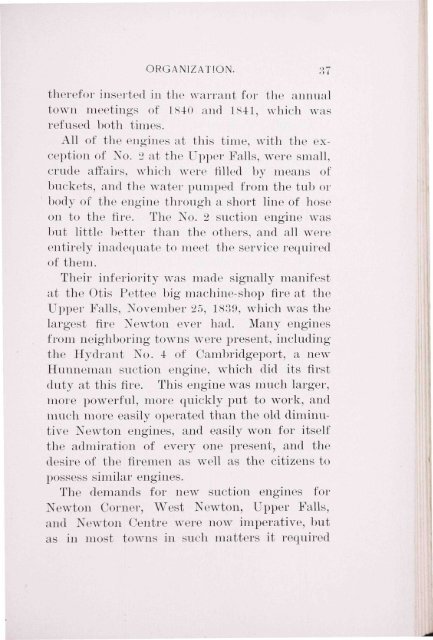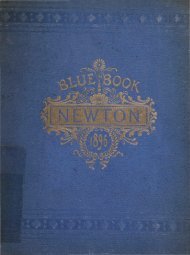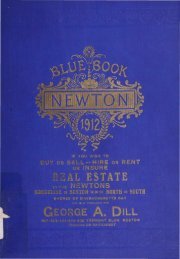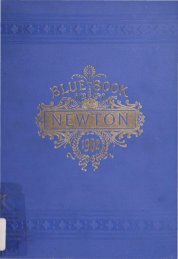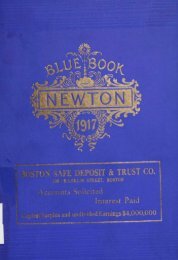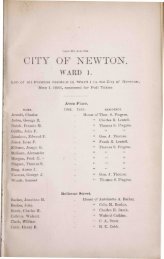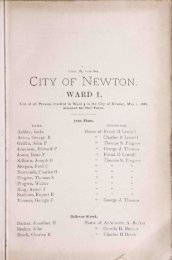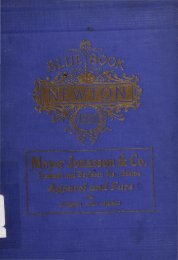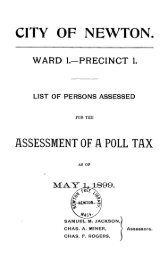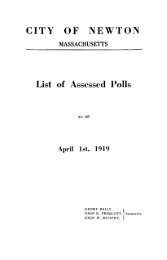- Page 1: • I ( I §
- Page 4 and 5: »' J- * J! J WALTER B. RANDLETT, C
- Page 6 and 7: E l' I- C ; \ n PRESS. B€)^fON. *
- Page 8 and 9: INTRODUCTORY. THE Newton Veteran Fi
- Page 10 and 11: CONTENTS. PAGE HISTORICAL SKETCH 13
- Page 12 and 13: HISTORY OF THF FIRE DEPARTMENT ( >F
- Page 14 and 15: 14 HISTORICAL SKETCH. of which Newt
- Page 16 and 17: 16 - HISTORICAL SKETCH. five years,
- Page 18 and 19: 18 HISTORICAL SKETCH. saw-mill, and
- Page 20 and 21: ORGANIZATION. j]HE first movement f
- Page 22 and 23: 29 ORGANIZATION. day of next month
- Page 24 and 25: 24 ORGANIZATION. As Newton's earlie
- Page 26 and 27: 26 ORGANIZATION. N rules and regula
- Page 28 and 29: 28 ORGANIZATION. located, and provi
- Page 30 and 31: 30 . ORGANIZATION. men of the towns
- Page 32 and 33: 32 ORGANIZATION. and to offer a rew
- Page 34 and 35: 34: ORGANIZATION. This engine was l
- Page 38 and 39: 38 ORGANIZATION. two or three years
- Page 40 and 41: 40 ORGANIZATION. "Your committee ar
- Page 42 and 43: !•_' ORGANIZATION. irood conditio
- Page 44 and 45: 44 ORGANIZATION. N The prayer of th
- Page 46 and 47: 46 ORGANIZATION. appliances were ne
- Page 48 and 49: 48 ORGANIZATION. and were operated
- Page 50 and 51: 50 ORGANIZATION. p. M., at which it
- Page 52 and 53: 52 ORGANIZATION. a committee, at th
- Page 54 and 55: 54 ORGANIZATION. hres it attended u
- Page 56 and 57: 56 ORGANIZATION. York. Old No. 4 ha
- Page 58 and 59: 58 ORGANIZATION. burned, January 14
- Page 60 and 61: 60 ORGANIZATION. FIREWARDS. 1818. S
- Page 62 and 63: (52 ORGANIZATION. ENGINEERS. NEWTON
- Page 64 and 65: 64 ORGANIZATION. LOWER FALLS. 1844.
- Page 66 and 67: 66 ORGANIZATION. 1844. 1845. 1840.
- Page 68 and 69: V \ CHIEF ENGINEERS. LUTHER PAUL, M
- Page 70 and 71: THE OLD COMPANIES. CATARACT No. 1.
- Page 72 and 73: 7»_> THE OLD COMPANIES. pointed. I
- Page 74 and 75: 74 THE OLD COMPANIES. \ their first
- Page 76 and 77: 76 THE OLD COMPANIES. This list inc
- Page 78 and 79: 78 THE OLD COMPANIES. Dennis Leonar
- Page 80 and 81: 80 THE OLD COMPANIES. where it rema
- Page 82 and 83: S2 THE OLD COMPANIES. Another compa
- Page 84 and 85: 84: THE OLD COMPANIES. stitution wa
- Page 86 and 87:
OFFICERS CATARACT ENGINE COMPANY No
- Page 88 and 89:
88 THE OLD COMPANIES. CONSTITUTION.
- Page 90 and 91:
90 THE OLD COMPANIES. ARTICLE 12. A
- Page 92 and 93:
92 THE OLD COMPANIES. in 1855 for $
- Page 94 and 95:
94 THE OLD COMPANIES. John A. Cass.
- Page 96 and 97:
OFFICERS WASHINGTON ENGINE COMPANY
- Page 98 and 99:
98 THE OLD COMPANIES. < 1824. Charl
- Page 100 and 101:
loo THE OLD COMPANIES. Harrison Nea
- Page 102 and 103:
102 THE OLD COMPANIES. firemen were
- Page 104 and 105:
10-1 THE OLD COMPANIES. opposite Wa
- Page 106 and 107:
106 THE OLD COMPANIES. 0. S. W. Bai
- Page 108 and 109:
108 THE OLD COMPANIES. It was subse
- Page 110 and 111:
110 THE OLD COMPANIES. MECHANIC No.
- Page 112 and 113:
112 THE OLD COMPANIES. Henry Billin
- Page 114 and 115:
114 THE OLD COMPANIES. want of men,
- Page 116 and 117:
110 THE OLD COMPANIES. NEWTON UPPER
- Page 118 and 119:
Lis THE OLD COMPANIES. ex-members m
- Page 120 and 121:
120 THE OLD COMPANIES. J. E. Trowbr
- Page 122 and 123:
122 THE OLD COMPANIES. accurate inf
- Page 124 and 125:
124 THE OLD COMPANIES. NONANTUM No.
- Page 126 and 127:
- 126 THE OLD COMPANIES. Edward Fis
- Page 128 and 129:
128 THE OLD COMPANIES. hose, and re
- Page 130 and 131:
130 THE OLD COMPANIES. in every way
- Page 132 and 133:
L32 THE OLD COMPANIES. a member of
- Page 134 and 135:
134 THE OLD COMPANIES. on Boston Co
- Page 136 and 137:
136 THE OLD COMPANIES. played into
- Page 138 and 139:
138 THE OLD COMPANIES. the engine w
- Page 140 and 141:
140 THE OLD COMPANIES. John M. Fisk
- Page 142 and 143:
142 THE OLD COMPANIES EMPIRE No. 5.
- Page 144 and 145:
144 THE OLD COMPANIES. B. Moore, wh
- Page 146 and 147:
146 THE OLD COMPANIES EAGLE No. 6.
- Page 148 and 149:
148 THE OLD COMPANIES. Joseph Liver
- Page 150 and 151:
150 THE OLD COMPANIES. was but a li
- Page 152:
152 THE OLD COMPANIES. and in every
- Page 155 and 156:
THE OLD COMPANIES. 155 tinguish fir
- Page 157 and 158:
THE OLD COMPANIES. 157 Its last dut
- Page 159 and 160:
THE OLD COMPANIES. 150 WILLIAM CLAF
- Page 161 and 162:
THE OLD COMPANIES. 161 The engine a
- Page 163 and 164:
THE OLD COMPANIES. 103 Its first an
- Page 165 and 166:
THE OLD COMPANIES. 165 engine was s
- Page 167 and 168:
PRESENT DEPARTMENT. 1
- Page 169 and 170:
C. S. Fields. J. McDonald. F. H. Ha
- Page 171 and 172:
PRESENT DEPARTMENT. 171 Past and Pr
- Page 173 and 174:
PRESENT DEPARTMENT. 173 F. A. Dexte
- Page 175 and 176:
C. A'. Kncvwles. J. Q. A. Hawkes. F
- Page 177 and 178:
PRESENT DEPARTMENT. 177 which was s
- Page 179 and 180:
PRESENT DEPARTMENT. 179 1874.— Ge
- Page 181 and 182:
PRESENT DEPARTMENT. 1*1 receiving,
- Page 183 and 184:
PRESENT DEPARTMENT. 183 Parse, 1876
- Page 185 and 186:
HOSE NO. A- E. C Waterhouse, Forema
- Page 187 and 188:
PRESENT DEPARTMENT. 187 HOSE No. 5.
- Page 189 and 190:
PRESENT DEPARTMENT. 18!» handed, a
- Page 191 and 192:
A. B. Hayden, Foreman. T. E. Healy.
- Page 193 and 194:
PRESENT DEPARTMENT. 193 HOSE No. 7.
- Page 195 and 196:
PRESENT DEPARTMENT. 195 walk, passe
- Page 197 and 198:
. \ John W. Murry, Foreman. Frank T
- Page 199 and 200:
PRESENT DEPARTMENT. 199 five dollar
- Page 201 and 202:
F. B. Sisson, Foreman. T- C Nickers
- Page 203 and 204:
PRESENT DEPARTMENT. 203 TRUCK No. 2
- Page 205 and 206:
PRESENT DEPARTMENT. 205 Marsters, W
- Page 207 and 208:
FIRES. IESPITE the fact that it is
- Page 209 and 210:
FIRES. 209 1844. May 7, Otis Pettee
- Page 211 and 212:
FIRES. 211 1854. July 17, E. C Dudl
- Page 213 and 214:
FIRES. i>l?> 1881. March 27, Richar
- Page 215 and 216:
FIRES. 215 1868. December 4, Binney
- Page 217 and 218:
FIRES. 21 i 1872. Xovember 13, D. S
- Page 219 and 220:
FIRES. 210 1801. 185)3. 1804. 1895.
- Page 221 and 222:
MISCELLANEOUS. 221 No. hand-engine
- Page 223 and 224:
MISCELLANEOUS. 223 FIREMEN'S RELIEF
- Page 225 and 226:
MISCELLANEOUS. 225 of which he was
- Page 227 and 228:
MISCELLANEOUS. 227 of Cataract No.
- Page 229 and 230:
MISCELLANEOUS. 229 challenge to the
- Page 231 and 232:
MISCELLANEOUS. 231 Peter Lyon Solom
- Page 233 and 234:
m > D O c > m m m m m > > O Q > O s
- Page 235 and 236:
VETERAN ASSOCIATION. 235 changed to
- Page 237 and 238:
• .'.V & \ ^ I J 7f^r'ViwmDrfn'\*
- Page 239 and 240:
'* . ' * THE BANNER
- Page 241 and 242:
BOOTS and SHOES. FINE LINE OF PATEN
- Page 243 and 244:
! FRED. L COOK, MPORTED AND DOMESTI
- Page 245 and 246:
GEORGE M. FISKE. WILLIAM HOMES. J.
- Page 247 and 248:
THE HASTEN & WELLS FIRE WORKS H'F'G
- Page 249 and 250:
W. H. FRENCH, Plumber, Gas=Fitter,
- Page 251 and 252:
ELBRIDGE BRADSHAW, NEWTONVILLE, HAS
- Page 253 and 254:
FRANK L. TAINTER. CIRCULATING LIBRA
- Page 255 and 256:
J. B. FULLER & CO. WINE MERCHANTS,
- Page 257 and 258:
GEORGE W. BUSH, LIVERY, HACK, AND B
- Page 259 and 260:
VETERAN FIREMEN ARE LEADERS WHETHER
- Page 261 and 262:
H. W. CRAFTS, Beef, Lamb, Hams, Por
- Page 263 and 264:
FINE MILLINERY. DRESSMAKERS' SUPPLI


